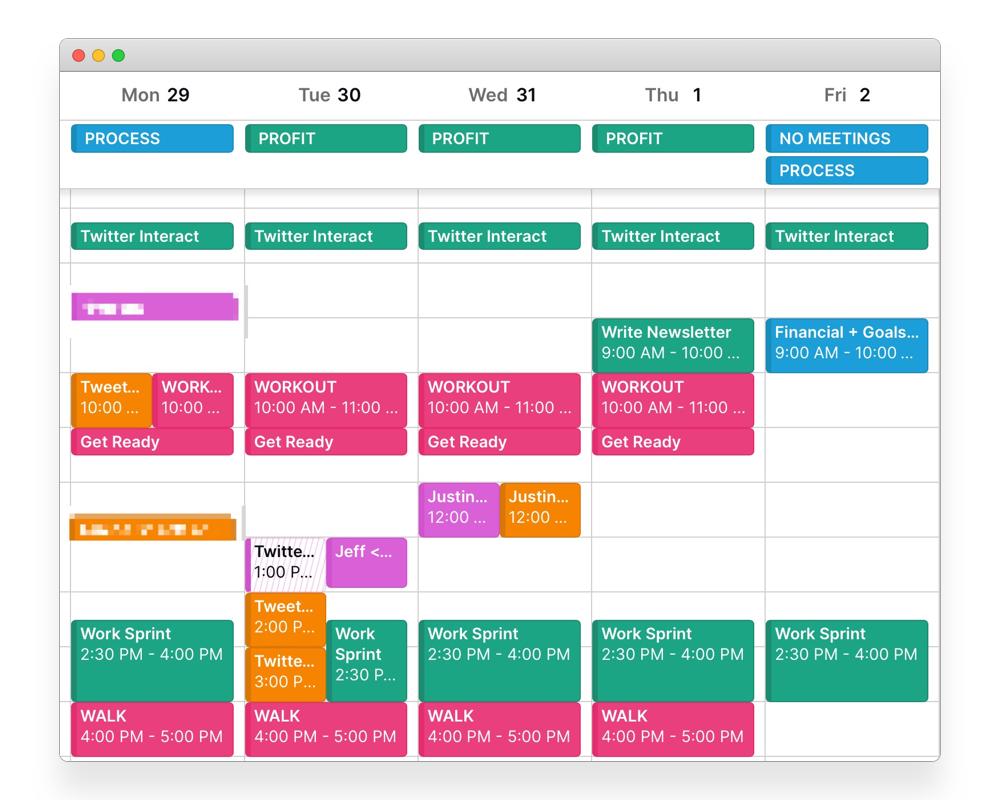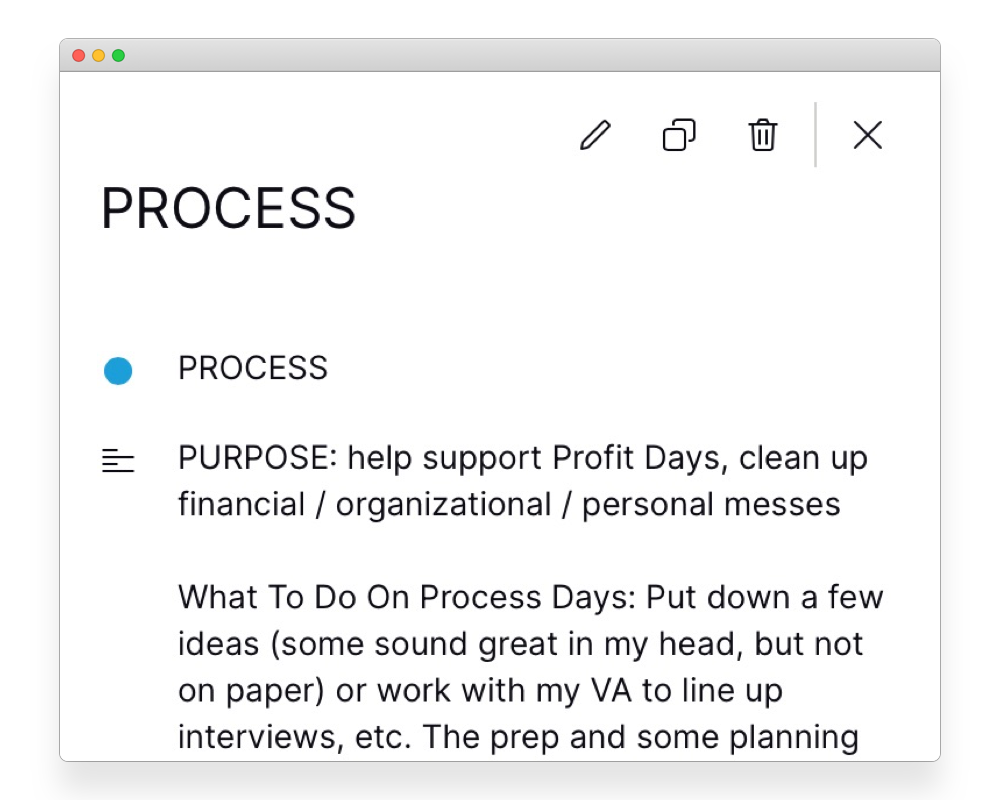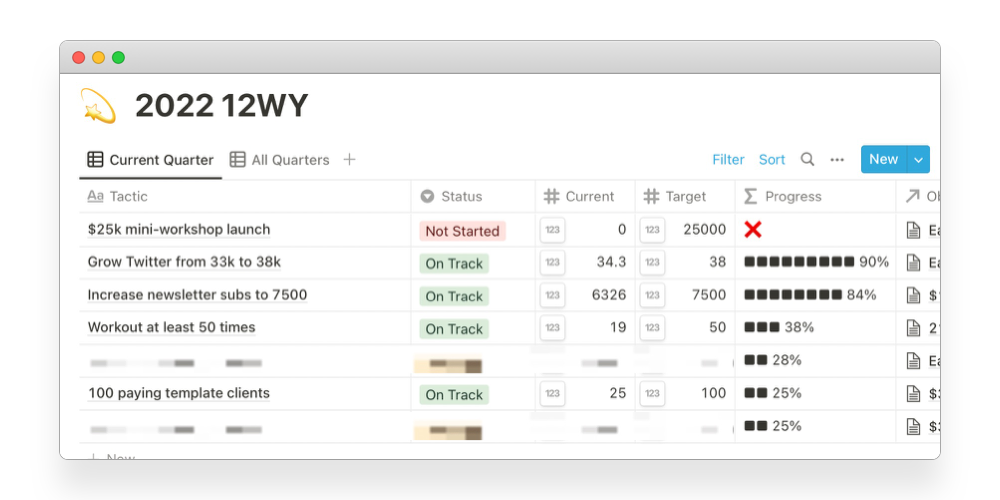TDW #004: 4 Steps to Design Your Ideal Week

In this week’s Different Weekly, I’m going to show you how to use your weekend downtime to set up your ideal week.
By replicating this process, you’re much more likely to live by design instead of default. As the name suggests, living by default is when you allow outside forces to control the majority of your time. Living by design means you set the pace, direction, and trajectory of your life.
Life hack:
— Justin Wise (@JustinWise) January 15, 2022
Use your weekend to set up the ideal life you want during the week.
Reality check: most folks are in default mode. So they’re constantly in a reactive state. Pushed from one emergency to another.
If that's you, don’t worry. Today’s edition is going to change that.
Your systems define your results.
And your time system is never more apparent than when you look at your calendar. Do you like what you see? Are you spending time doing the activities you enjoy? Are you working too much? Too little?
These are all systems-related questions.
If you don’t like what you’re seeing, or just want to optimize your current life rhythm, you’ll need to address the underlying systems you have in place.
It’s important to note that how you spend your time has both quantitative and qualitative aspects.
Quantitative: as the minutes and seconds slip through hourglass, what are you actually spending your time doing? Which activities fill up your calendar?
Qualitative: as you ‘do the work,’ how much of it do you enjoy? Is it fulfilling? Is time flying or dragging? What’s the quality of your schedule?
If you're like most entrepreneurs, a quick scan of your calendar might reveal you’re spending just five hours per week (quantitative) doing work you enjoy (qualitative). This means the other 40+ hours (quantitative) are filled with work you don’t enjoy (qualitative).
This happens so easily and quickly most of the time we don’t even realize. This is the fast-track to living by default.
Here’s a step-by-step weekly time system you can use to build your ideal life.
Step 1: Calendar Review

Every Sunday evening I sit down and review my calendar for the upcoming week. There are two main components to my schedule (more on these in the next step):
- Permanent time blocks
- Variable time blocks
The main reason for the review is simple: I hate calendar surprises. I want to know what’s coming well in advance. If I need to make any changes, additions, or deletions–or get clarification on an appointment–this is when I do it.
I like setting expectations with myself and my VA team going into the week. It reduces the amount of stress and calendar missteps. If I have a question about something, I’ll send it to my VA team in Slack. They respond within hours on Monday morning.
Total amount of time spent: 5 minutes each week.
Step 2: Time Blocking

If there’s one step in this system that’s paid the biggest dividends for me over the years it’s time blocking.
Simply put, I block out time in advance for high-yield, high-priority tasks. As mentioned, they come in two flavors: permanent & variable.
Permanent time blocks include:
- Content creation
- Network engagement & interaction
- Workouts
- CEO ‘stuff’ (finances, goals, management, etc.)
These blocks are typically set from 8a-12p.
Permanent time blocks are kinda like saving or investing: you “pay” yourself first with the best spots on your calendar for the most important tasks. They’re non-negotiable. They don’t move. And my VA team knows to not touch these without asking first if an adjustment is needed.
Variable time blocks include:
- Client meetings
- Discovery calls
- Coaching calls
- Podcast interviews
These blocks are typically set from 12-2p.
If I’m going to have a meeting, it’s happening in a variable time block. The hours are protected in my online scheduler. My VA team knows to schedule any outside requests here.
Quick note: when I first started doing this, I thought clients would have a massive issue with it. But surprisingly, no one even noticed. Or cared. I wish I would have made the change earlier.
Total amount of time spent: 1-2 hours initial setup; ~5 minutes to review each week.
Step 3: Goal Review

Each quarter I sit down and create new goals. Each new quarterly goal must be connected to a yearly goal I set at the beginning of the year. I then review both sets of goals (annual and quarterly) each week.
What I’m looking for here is alignment. Am I still aligned with the goals I set for myself? I’m asking questions like:
- Do these goals still make sense?
- Am I still committed to these goals?
- Is pursuing these goals still the highest and best use of my time?
Most times the answer is YES.
Occasionally the answer is NO. And when it’s a NO, it’s time to pivot. There’s nothing worse than pursuing a goal that doesn’t make sense or you’re no longer committed to.
For instance, I had a goal at the beginning of the year to hit 75,000 followers on Twitter. It became pretty clear at the end of Q1 that, unless something drastically changed, I wasn’t gonna come close to that number.
So…I changed the number.
This is also where my permanent time blocks come from. Nearly every block relates back to a goal. I’m giving myself the highest probability of success by blocking off time to achieve my desired outcome.
Total amount of time spent: 5 minutes each week.
Step 4: Weekly Sprint

I heard Jason Fried of Basecamp fame talk about “Post-It Note Productivity” once. Never forgot it.
The gist is instead of using a long and cluttered to-do list, you write your tasks for the day on a Post-It note. With a fat-tip Sharpie marker. Why? Because a Post-It only allows room for three tasks. (And the Sharpie keeps you honest–no small writing allowed!)
I adopted this approach and put it on a Notion board instead.
At the end of my weekly review I’ll write out tasks for the week. Three “MITs” (Most Important Task) per day. I don’t always fill up every task. And some tasks are recurring. But the bulk of my week is planned before I hit the ground running Monday morning.
The Weekly Sprint is the culmination of the whole process:
Calendar Review allows → Time Blocking allows → Goal Review allows → Weekly Sprint.
Total amount of time spent: 15 minutes each week.
Next Steps
So if you add up all the steps, we’re at 30 minutes. Half an hour each week to set yourself up for massive success throughout the week. Designing the life you want instead of the one handed to you.
Do you have to do this on your weekend? No, of course not. If there’s a day that works better for you–great. Do it then. The important part is to make your time system start working for you, not against you.
And if you’re feeling overwhelmed or don’t know where to start, pick the step that resonated with you the most. Start there. Take it in small pieces.
I’ve been optimizing this process for years. And it’ll never be perfect. But it’s a great way to start living by design instead of default.
That’s all for this week.
Talk soon,
Justin
When you’re ready, here’s how I can help you:
- NEW: Steal my best-performing content for just $9/month. (limited to 100 members)
- Attract and convert more of your dream clients here. (200+ students)
- Watch this video if you want 3 more clients for your most expensive offer.
Join the 7000+ creators & entrepreneurs growing their brands + income.
Contrast, Don't Comply. I'll Teach You the Wisdom of Doing Different & the Folly of Following the Status Quo.
We hate SPAM. We will never sell your information, for any reason.
